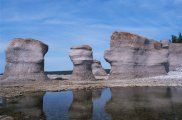Earth Science Final Review
1. What are the three main types of fossil fuels and where did each originate?
2. Explain the difference between renewable and non-renewable resources.
3. What are the two potential sources of major earthquakes in Portland? Which one is more likely to cause the most damage?
4. Describe what causes an earthquake.
5. List the three types of plate boundaries and name a landform that is associated with each.
6. What scale measures the shaking force of an earthquake?
7. Explain the difference between quantitative and qualitative data. Give an example of each.
8. Compare shield volcanoes and composite volcanoes. Reference height, shape, and lava type.
9. Draw a line of triangles on the map below to indicate a major volcanic belt. Name this volcanic belt.
10. Name the following processes in the water cycle (1pt each)
1. Water is heated by the sun and moves into the atmosphere.
2. Water falls from the atmosphere.
3. Water moves downhill across the surface of the land.
4. Water seeps through soil into aquifers.
5. Water moves from plants into the atmosphere.
6. Water vapor becoming a cloud.
7. Water moving in aquifers below the surface of the ground.
11. What is a watershed?
12. Name ten ways you can reduce water use in your home.
13. Which sectors consume the most water in developed countries?
14. Which sectors consume the most water in undeveloped countries?
15. Explain how scientists use Carbon-14 to date fossils.
16. Explain the law of superposition.
17. Write the eras in order from most recent to oldest. Label each with their absolute dates and provide a description of each.
18. What are ten things that a coastal community can do reduce the damage done by a tsunami?
